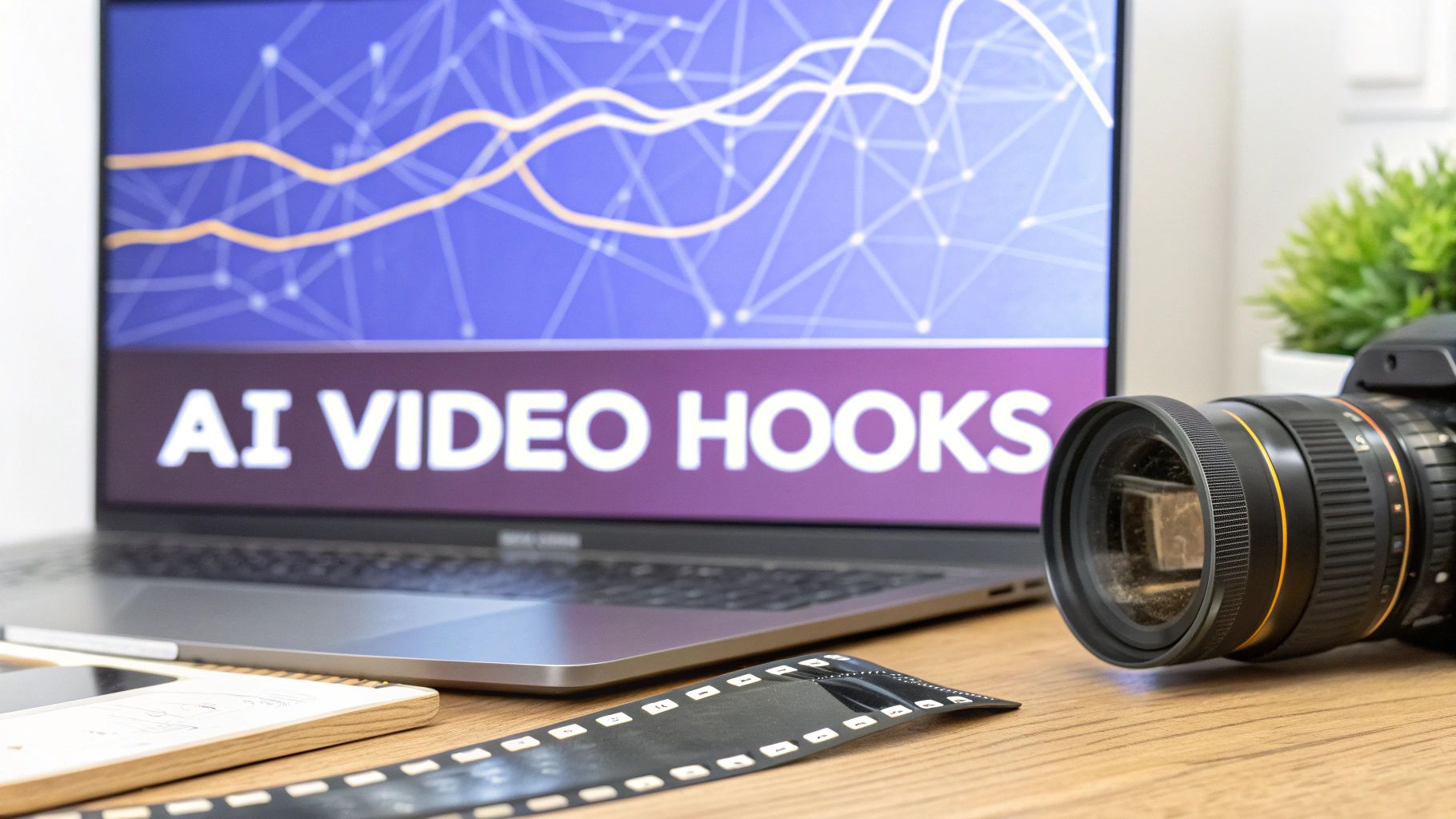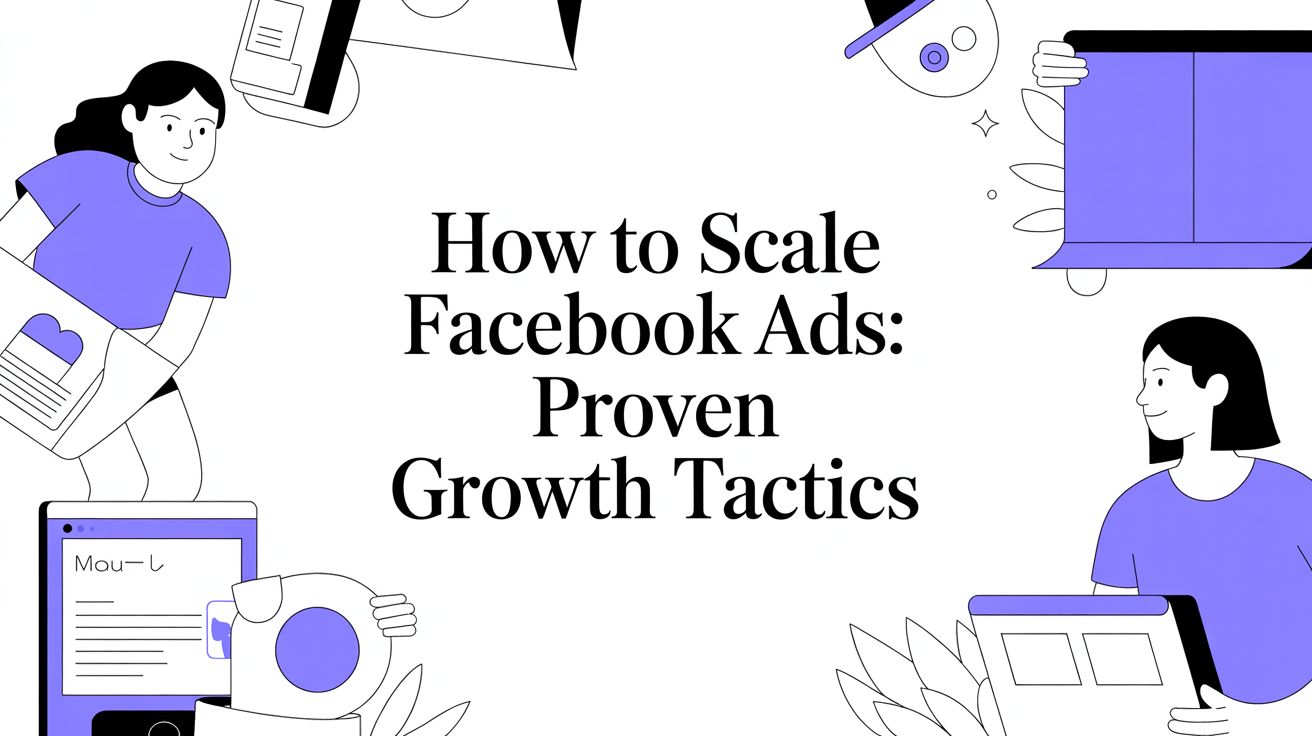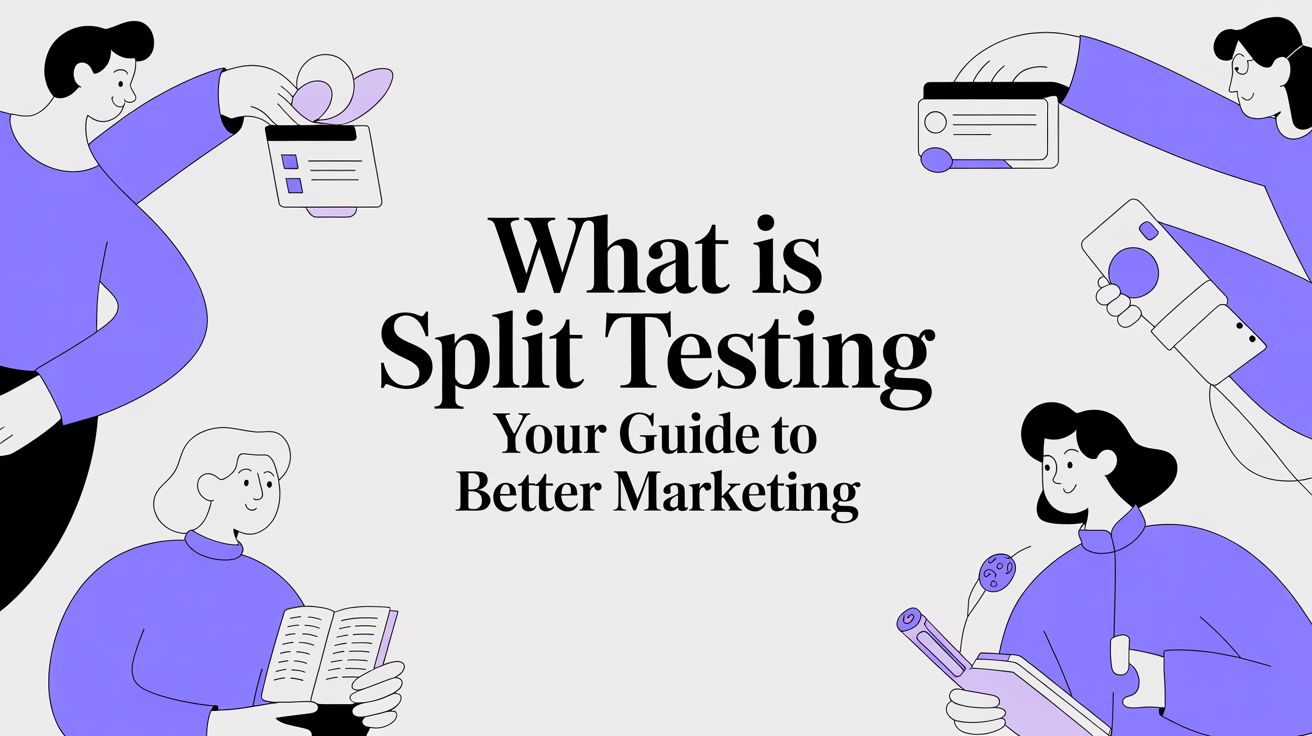To really nail your video hooks with AI, you have to think beyond just the script. The magic happens when you pair AI-generated ideas with automated visual editing. This combo lets you quickly figure out what actually stops people from scrolling, turning a shot in the dark into a smart, data-backed strategy.
Why Those First Three Seconds Are Everything
You’ve probably heard a million times that attention spans are shorter than ever. That’s not quite right. It’s not that people can't focus; it's that they have infinite options. When someone is scrolling through their feed, they're making split-second decisions about what's worth their time. Those first three seconds are your entire pitch.
A great hook is more than just clickbait. It’s a psychological nudge that promises value. It could be a bold question, a surprising statistic, or just an image so unusual it breaks the visual monotony of their feed. The goal is to make a massive first impression and learn how to boost social media engagement.
Moving from Guesswork to Data
In the past, coming up with the perfect hook was all about gut feeling and experience. You’d make a video, post it, and hope for the best. If it tanked, you were left wondering why, with a slow and murky feedback loop.
Key Takeaway: AI flips this entire process on its head. It turns a guessing game into a science experiment. Instead of spending hours on one perfect hook, you can spit out a dozen different versions in minutes, each with its own unique angle, tone, or visual flair.
This isn't just some fringe tech anymore; it's becoming the standard. The AI video generator market was already valued at USD 534.4 million in 2024 and is expected to balloon to USD 2.56 billion by 2032. What’s driving this crazy growth? AI’s power to churn out compelling hooks by automatically turning scripts into video, recognizing faces, and personalizing content on a massive scale. You can get the full scoop on these AI video generator market trends to see just how big this is getting.
How This Looks in the Real World
Let's talk about how this actually plays out for businesses and creators.
For an E-commerce Brand: Picture a company launching a new skincare line. Instead of creating a single, generic ad, they can use an AI tool to generate ten different 5-second hooks. One hook might be a dramatic "before-and-after" shot, another could feature a glowing customer testimonial, and a third might zoom in on a rare, powerful ingredient. By running all ten, they can quickly see which one actually gets people to click and buy.
For a Content Creator: A YouTuber trying to go viral can use AI to brainstorm hooks around trending topics or polarizing opinions. The AI might suggest starting the video with lines like, "You've been brewing your coffee all wrong," or "Here's the one productivity hack nobody is telling you." This gives them a handful of powerful, attention-grabbing starting points right out of the gate.
At the end of the day, using AI for hooks isn't about killing creativity. It’s about supercharging it. It gives you the power to test more ideas, learn from your audience faster, and give your videos the best possible shot at success, right from the first frame.
How To Choose The Right AI Video Tool For Your Hooks
Picking the right AI video tool can feel overwhelming with all the options out there. The trick isn't to find the flashiest tool, but the one that actually fits your workflow, skill level, and budget. A great tool is one you’ll consistently use to create those killer hooks.
First, get clear on your main goal. Are you a solo entrepreneur needing to create social media clips on the fly? A simple text-to-video generator is probably your best friend. These tools are built for speed and ease, letting you turn a script idea into a video in minutes.
But if you’re a marketing agency juggling several clients, you’ll need more horsepower. In that case, look for an advanced platform with a full editing suite, detailed analytics, and the ability to handle high volumes. This gives you the control to fine-tune every detail for polished, professional video ads.
This visual shows exactly how AI tools integrate into a modern content strategy to drive up engagement.
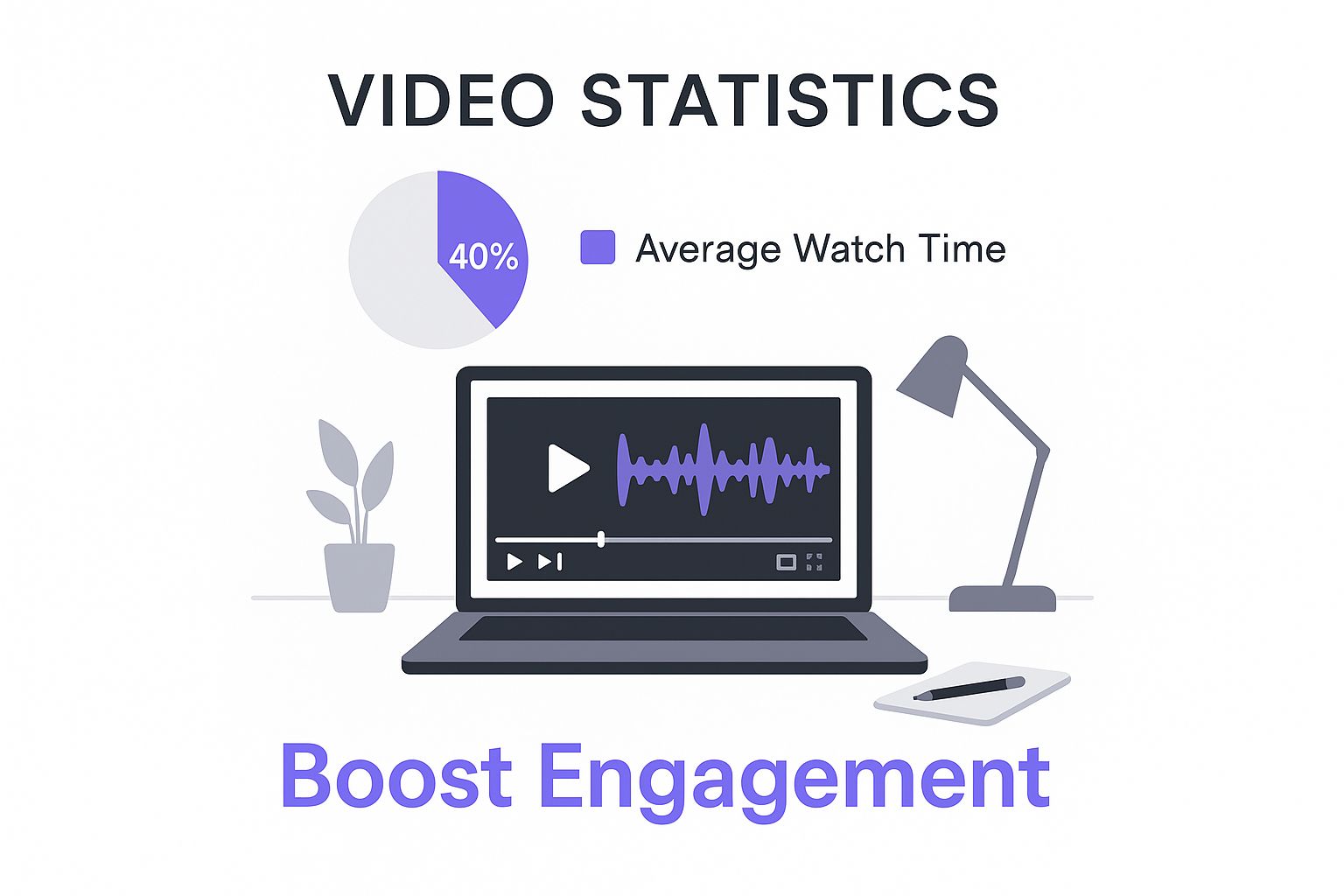
The image really drives home that boosting engagement is the ultimate goal, and AI video creation is a critical lever to pull.
Core Features To Look For
No matter your specific needs, some features are simply non-negotiable for crafting hooks that work. Don't get distracted by bells and whistles; focus on what truly makes a difference.
- Hook Generation Prompts: A good tool should be a creative partner, helping you brainstorm compelling hook ideas—not just execute them.
- AI-Powered B-Roll: Look for access to a massive stock footage library where the AI is smart enough to suggest relevant clips that match your script.
- Voice Options: High-quality text-to-speech and voice cloning are crucial. Nothing kills a great hook faster than a robotic, unnatural voice.
- Automated Captions: With so many people watching videos on mute, auto-captions are a must for both accessibility and engagement.
The growth in this space is incredible. The global AI video market was valued at USD 3.86 billion in 2024 and is expected to rocket to USD 42.29 billion by 2033. This flood of investment is what's driving the rapid improvement of these key features.
AI Video Tool Feature Comparison
To help you decide, here's a quick breakdown of how different types of AI video tools stack up against each other. Think about which column aligns best with your primary goals.
| Feature | Text-to-Video Generators (e.g., InVideo AI) | AI Video Editors (e.g., Descript) | Comprehensive Platforms (e.g., Synthesia) |
|---|---|---|---|
| Primary Use Case | Rapidly creating short videos from text for social media. | Editing existing video/audio with AI features like filler word removal. | Creating high-quality, scalable videos with AI avatars and voice cloning. |
| Hook Generation | Strong. Often has built-in prompters and idea generators. | Limited. Focus is on editing, not initial idea creation. | Moderate. Some platforms offer script helpers, but it's not the core function. |
| Ease of Use | Very High. Designed for beginners with minimal editing skills. | Medium. Requires some familiarity with editing concepts. | Medium to High. Can be complex due to advanced features like avatar creation. |
| Customization & Control | Low. Template-based, with limited control over fine details. | High. Full control over the editing timeline, effects, and audio. | Very High. Extensive control over avatars, voices, branding, and templates. |
| Best For | Social media managers, solo creators, and small businesses needing speed. | Podcasters, YouTubers, and content creators who need to refine raw footage. | Enterprises, L&D teams, and marketing agencies needing polished, scalable content. |
Ultimately, the "best" tool is the one that solves your specific problem. A text-to-video generator is perfect for quick turnarounds, while a comprehensive platform is an investment for larger-scale, polished productions.
Matching A Tool To Your Use Case
Let's make this even more practical. A creator cranking out daily TikToks has completely different requirements than a large e-commerce brand launching a new product line. For that solo creator, diving into the https://sprello.ai/blog/12-best-ai-video-maker-for-tiktok can offer platform-specific advice that makes all the difference.
My Advice: Your budget is obviously a big deal here. The good news is that most top-tier tools offer free trials or credit-based plans. I always recommend using these to test drive the workflow. See if the quality and style of the final videos match your brand before you even think about committing to a subscription.
Choosing the right tool is a strategic move that will directly impact your content's success. When you focus on your specific goals and the core features that drive views, you'll find a platform that becomes a true partner in your creative process. To get a bigger picture of how this fits into your marketing, it's worth exploring the power of AI for content creation.
Getting AI to Write a Killer Hook Script
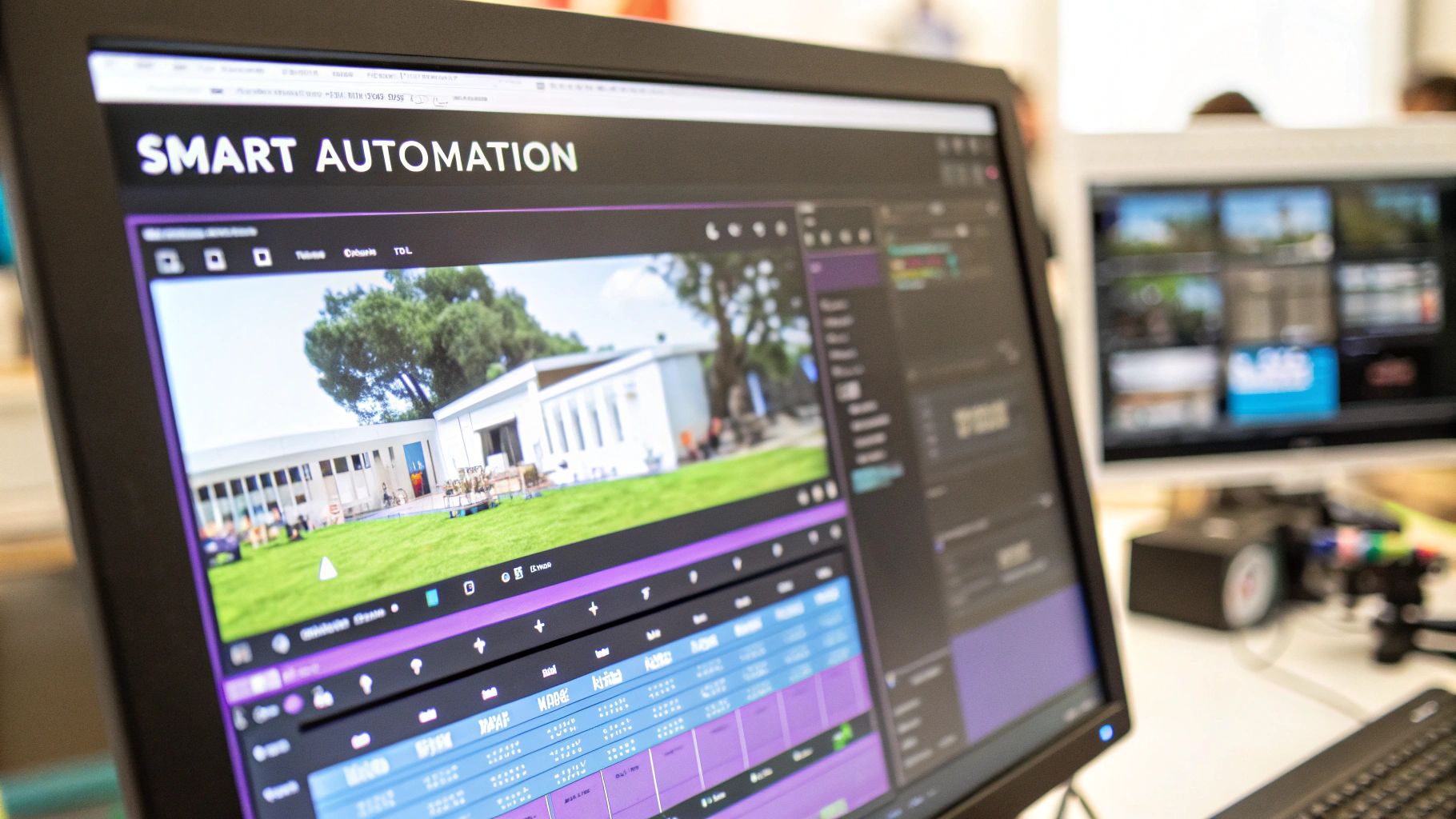
Alright, this is where the fun really starts. Getting a great script from an AI isn't about just asking for "a good hook." It’s a creative partnership. You need to give the AI clear, specific directions to act as your co-writer. The quality of what you get out is directly tied to the quality of what you put in.
I always think of it like ordering coffee. If you just say "a coffee," you'll get a generic black drip. But if you ask for "a large iced oat milk latte with one pump of vanilla," the barista knows exactly what to do. Same deal here.
From Vague Ideas to Powerful Prompts
To get attention-grabbing hooks, you have to master the art of the prompt. Vague prompts give you generic, robotic-sounding scripts that nobody wants to watch. Layered, specific prompts? That's where you find the gold.
So, instead of a lazy prompt like this: "a hook about a new cold brew maker."
Try something much more detailed: "Generate five scroll-stopping hooks for a 15-second TikTok video. The product is a new portable cold brew maker. My target audience is busy professionals, 25-40, who love coffee but hate waiting. I want to use a problem-solution angle with a humorous, relatable tone."
See the difference? This prompt gives the AI the essential context it needs to deliver something useful.
- Platform: TikTok (which means short, fast, and trendy)
- Product: Portable cold brew maker
- Audience: Busy professionals (so we can speak to their pain points)
- Angle: Problem-solution (a classic marketing framework that just works)
- Tone: Humorous and relatable (this defines the brand voice)
Just making that simple shift in how you ask can take you from a weak idea to a script that's 80% of the way to perfect.
Refining and Iterating on What the AI Gives You
The first thing the AI spits out is almost never the final version. Think of it as a great starting point—a block of marble you get to sculpt. Your job is to take the best concepts and polish them with your own human expertise and brand knowledge.
Don't just grab one hook and call it a day. The real magic happens when you start blending and iterating. An AI might give you three decent but unremarkable hooks. But a sharp creator will notice that the opener from the first hook, combined with the question from the third, creates something genuinely compelling.
Pro Tip: Never trust an AI hook blindly. Always, always read it out loud. Does it sound like something a real person would say? Does it fit your brand’s voice? Sometimes, swapping a single word or rephrasing a sentence is all it takes to go from good to great.
When you're in this phase, it can be a huge help to explore the best AI for brainstorming to spark even more creative angles you might not have considered.
Setting Up Your Scripts for A/B Testing
One of the biggest wins of using AI is how fast you can generate multiple hook variations. This makes A/B testing the first three seconds of your video incredibly easy and powerful. Stop guessing which hook is best and let your audience tell you what actually works.
Whip up a few distinct versions of your script:
- The Question Hook: "Still waiting 20 minutes for your morning cold brew?"
- The "You're Doing It Wrong" Hook: "You've been making your cold brew all wrong."
- The Solution-First Hook: "Get perfect cold brew in just 60 seconds with this."
Turn these scripts into short video ads and test them. You'll quickly see which one earns the highest retention and click-through rate. It's a data-driven approach that completely removes the guesswork.
For anyone wanting to go deeper on this, our guide on how to create AI video ads walks through the entire process from start to finish. This is how you turn AI from a simple scriptwriter into a strategic partner that helps you optimize performance.
Producing Your Hook from Script to Screen
A killer script is the starting point, but let’s be honest—it’s the execution that actually stops the scroll. This is where you have to turn those carefully chosen words into something that grabs people by the eyeballs. Thankfully, modern AI video tools have made this part of the job faster and, frankly, better than ever before.
https://www.youtube.com/embed/CZ55ELWlvoY
I remember spending countless hours digging through stock footage sites for that one perfect clip. Now, you can feed a script directly to an AI, and it does the heavy lifting for you. The tool analyzes your text and instantly pulls relevant video clips from huge libraries. This simple shift in workflow frees you up to think about the creative side of things instead of getting bogged down in tedious searches.
Assembling Your Visuals and Audio
Those first few seconds are everything. They need to land with a punch, which means your visuals have to match the energy and message of your hook perfectly. This is an area where AI tools really shine by quickly assembling a sequence of clips that mirrors the pace of your script.
Take a hook like, "This one mistake is killing your productivity." An AI might instantly string together a quick montage for you: a shot of a cluttered desk, a close-up of someone looking stressed, and maybe a calendar jam-packed with meetings. It’s instant visual storytelling that drives your point home before the viewer even has a chance to get bored.
Of course, video isn't just about what you see. Audio is just as important, and most platforms give you a few powerful ways to handle it:
- AI Text-to-Speech: The latest AI voices are shockingly realistic. You can generate a clean, professional-sounding voiceover in a matter of seconds without needing a microphone or a quiet room.
- Voice Cloning: If you want to keep things personal, you can clone your own voice. This gives you the best of both worlds—the speed and convenience of AI with the authenticity of your unique sound.
- Auto-Captions: So many people watch videos with the sound off. Automatically generated captions are no longer optional. Good tools will not only create them for you but also let you style them to match your brand.
Bringing a 5-Second Hook to Life
Let's walk through a real-world example. Imagine you have this 5-second script for an Instagram Reel: "Stop wasting money on coffee. This gadget makes barista-quality espresso at home for just 50 cents a cup."
Here’s how an AI tool would likely build this out:
- Scene 1 (0-2 seconds): For the line, "Stop wasting money on coffee," the AI would grab a clip of someone handing over a wad of cash at a trendy coffee shop.
- Scene 2 (2-4 seconds): For "This gadget makes barista-quality espresso," it would probably find a slick, satisfying close-up of your product brewing a perfect shot.
- Scene 3 (4-5 seconds): As the voiceover says "50 cents a cup," the AI would overlay bold, animated text that screams "$0.50/CUP" to make the value proposition impossible to miss.
This whole sequence can be put together in just a few minutes. Your job then becomes the fun part: tweaking it. Maybe you swap out one of the clips or adjust the timing of the text. It’s a powerful workflow that lets you create attention-grabbing hooks with AI video tools at an incredible pace.
There's a reason the market for these tools is absolutely exploding. It was valued at USD 1.6 billion in the mid-2020s and is on track to hit a staggering USD 9.3 billion by 2030. This boom is happening because AI is automating complex, time-consuming tasks like scene detection and color correction, putting professional-level video production into everyone's hands. You can dig into the AI video editing market insights to see just how fast this space is moving.
By weaving together AI-selected visuals, crisp audio, and dynamic text, you can produce polished hooks that actually work—and you can do it at a scale that used to require a whole production team.
Common Mistakes to Avoid When Using AI for Hooks
AI tools can be fantastic creative partners, but they aren't a magic wand. I've seen a lot of creators make the mistake of leaning too heavily on them, and the result is almost always a generic, forgettable hook. To truly create attention-grabbing hooks with AI video tools, you need to be the director, not just a passive observer accepting the first thing the machine spits out.
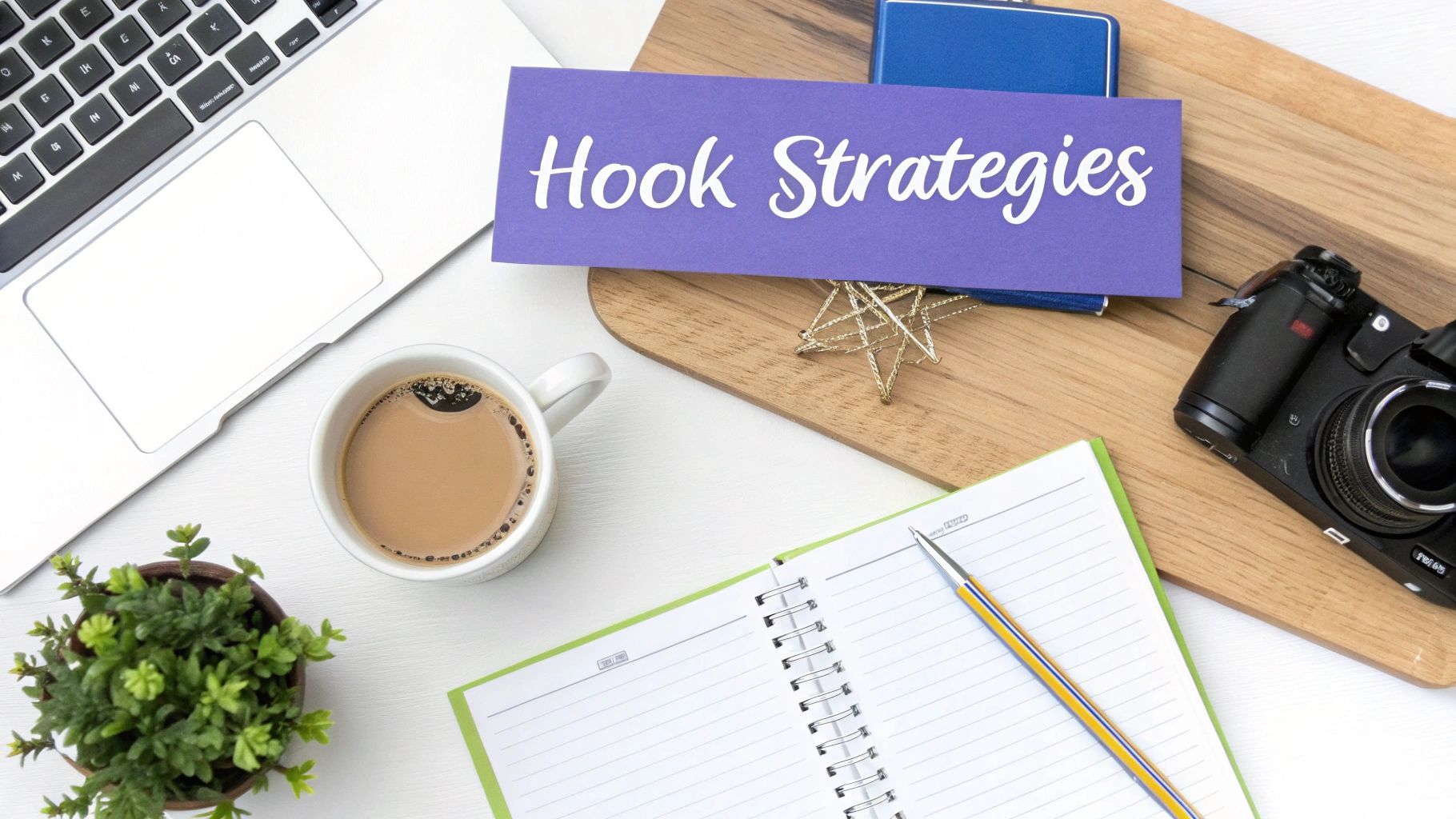
One of the biggest pitfalls is letting your brand’s unique voice get lost in the process. Remember, AI learns from a massive dataset of existing content, which means its default setting is often "average." It's your job to step in and infuse your brand's personality, humor, and specific point of view into whatever the AI generates.
Overlooking Technical Quality
Let's be honest: even a brilliantly written hook will completely fail if the technical side is a mess. I see creators stumble most often in two specific areas: audio and visuals.
- Robotic Voiceovers: Nothing screams "low-effort content" faster than a default, clunky AI voice. It immediately erodes trust and makes your entire video feel cheap.
- Irrelevant Footage: Just because the AI suggested a piece of B-roll doesn't mean it's the right choice. A clip that's only vaguely connected to your script will just confuse your audience and water down your message.
Think about it. A hook talking about a "game-changing" productivity app paired with a stock video of people typing is just… boring. You need dynamic visuals that actually show the benefit you're talking about. For a deeper dive on making sure your visuals and message are perfectly aligned, take a look at our guide on how to make video ads that convert.
What to Avoid: Slapping a generic, AI-generated script over a default text-to-speech voice and random stock clips. What to Do Instead: Treat the AI script as a first draft. Refine the language to sound like you. Use a high-quality voice clone for narration, and then manually review every single clip. Make sure each visual is powerful and directly supports what you’re saying.
Ignoring the Human Element
The single biggest mistake I see is thinking the AI can do all the work. It can't. Your audience wants to connect with a person, not an algorithm. That personal touch is what turns a good hook into a great one.
A hook that says, "This app saves you time," is instantly forgettable.
But what about one that starts with, "I used to waste 5 hours a week on this one painful task… until I found this"? That’s personal, specific, and relatable. Always find a way to weave your own story or perspective into the hook. This human-in-the-loop approach isn't just a good idea—it's crucial for success.
Questions on AI Video Hooks (and Some Real Answers)
Jumping into AI for video hooks naturally brings up a few questions. I hear them all the time. From worries about creativity to the practicalities of cost, it's good to know what you're walking into. Let's break down the most common ones with some straightforward, experience-based answers.
Can AI Actually Be Creative Enough for a Good Hook?
Yes, but think of it as a creative partner, not a solo artist. AI is fantastic at churning out a ton of ideas and different angles in seconds. It sees patterns in successful content that we might miss, making it an incredible brainstorming tool.
The real magic, though, happens when you guide it. Your unique prompts, your brand's specific personality, and your strategic goals are what spark true originality. I've found the best hooks come from letting the AI generate the initial concepts, and then I step in to add that human element—refining, tweaking, and perfecting it.
What's the Real Cost of These AI Video Tools?
The price tag on these tools is all over the map. Lots of them have free plans, which are perfect for getting your feet wet. They usually come with some limits, like a watermark on your video or a cap on how many you can make each month, but they're great for testing things out without pulling out your wallet.
Paid plans typically run anywhere from $15 to over $100 a month. The price really depends on what you need—higher-quality video, access to better stock footage, or advanced features like voice cloning. My advice? Always start with a free trial. Make sure the tool fits your workflow and your budget before you commit.
Will My Videos End Up Sounding Like a Robot?
They definitely can if you just hit "generate" and walk away. The secret to avoiding that generic, robotic feel is to get your hands dirty and customize the output. The AI's first draft is just that—a draft.
- Tackling the Audio: Today's AI voice tools give you a ton of control. You can play with the pitch, speed, and even the emotional tone. For the most authentic sound, I highly recommend using a voice cloning feature to use your own voice. It makes a world of difference.
- Nailing the Visuals: Don't just accept the video clips the AI suggests. Go through them and swap out anything that feels a bit bland or doesn't quite match your brand's look and feel.
How Do I Know If My AI-Generated Hook Is Any Good?
You measure an AI hook the same way you'd measure any hook: you let the data do the talking. The early engagement numbers will tell you the whole story.
Keep a close eye on your Audience Retention Rate. The most important number is the percentage of people still watching after the first 3 to 5 seconds. If you're running video ads, your Click-Through Rate (CTR) is king. A great tactic is to A/B test a few different AI-generated hooks to see which one performs best. Let the viewers decide for you.
Ready to stop guessing and start creating high-performing video ads in minutes? With Sprello, you can turn your ideas into compelling, UGC-style videos using the power of AI. Start your free trial today and see how easy it is to scale your video content.
